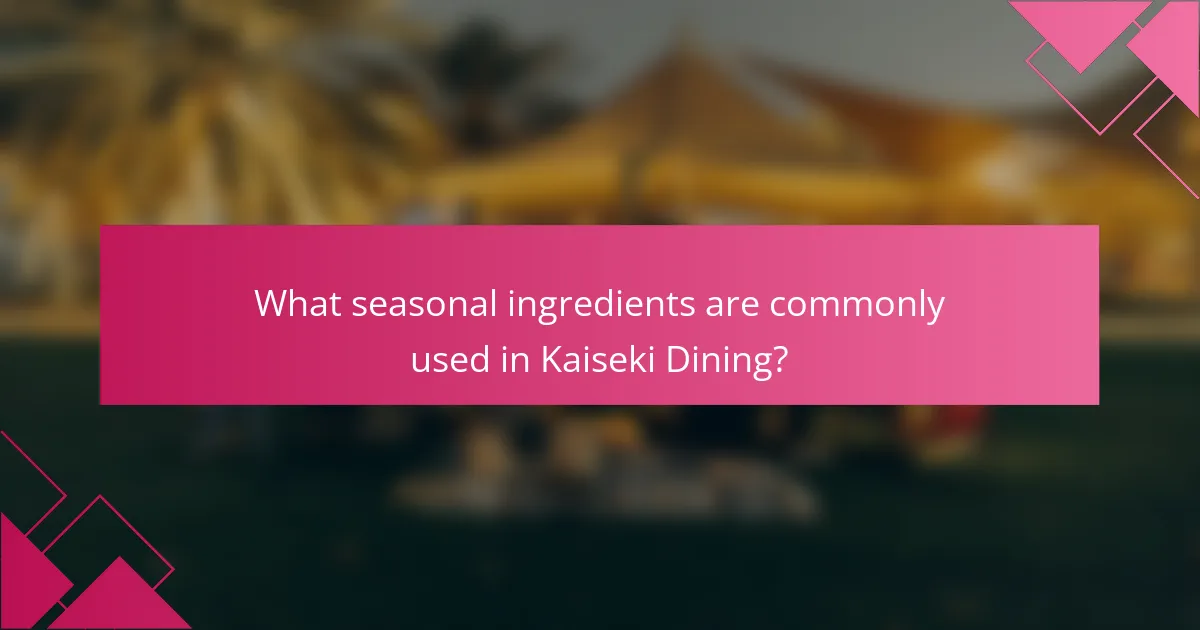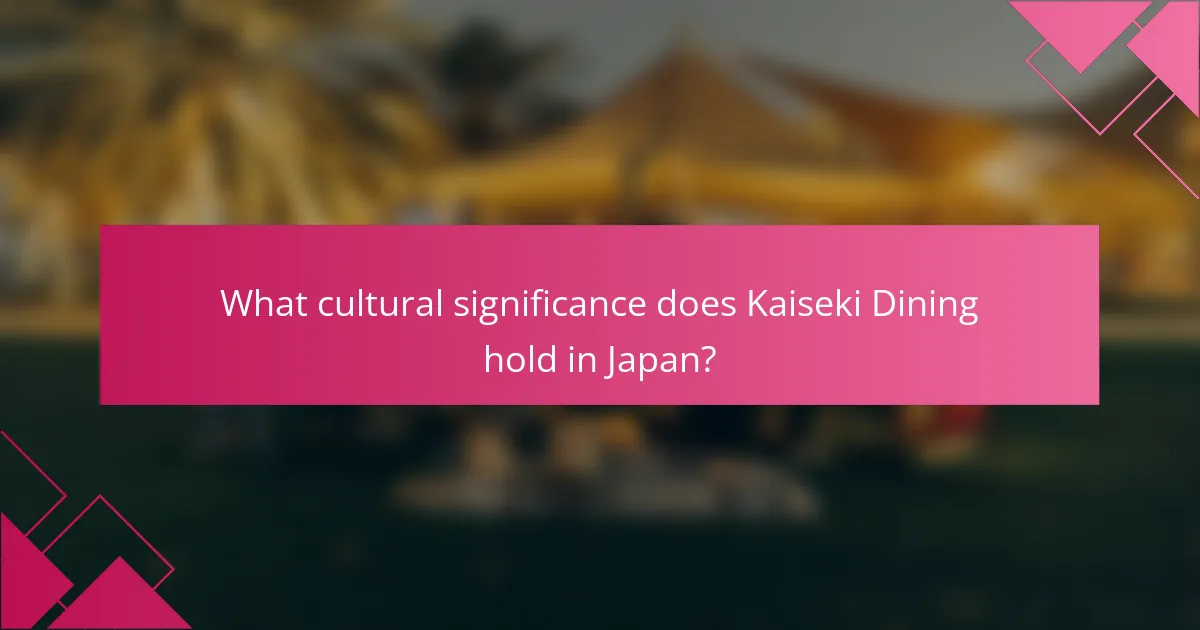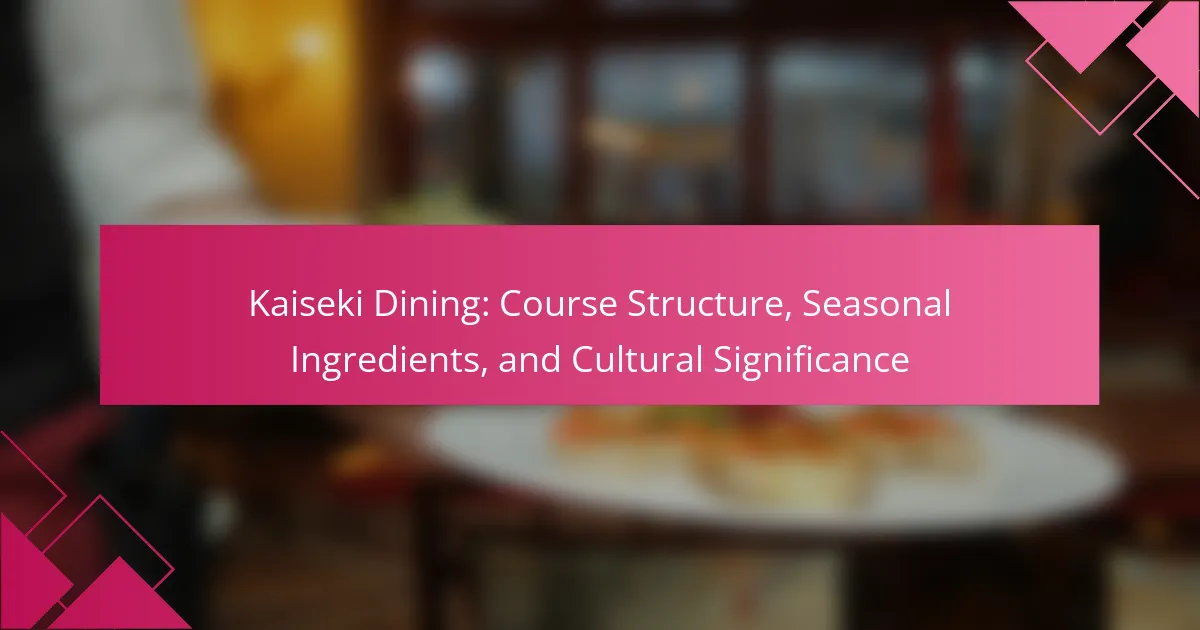
What is Kaiseki Dining?
Kaiseki dining is a traditional multi-course Japanese meal. It emphasizes seasonal ingredients and meticulous presentation. Kaiseki originated from the Japanese tea ceremony. The meal is designed to enhance flavors and textures. Each course is served in a specific order, showcasing culinary skill. The courses typically include appetizers, sashimi, grilled dishes, and desserts. Kaiseki reflects the philosophy of harmony with nature. Its cultural significance lies in its artistry and attention to detail.
How did Kaiseki Dining originate in Japanese culture?
Kaiseki Dining originated from the Japanese tea ceremony. It evolved from the simple meal served to guests during the tea ceremony. Over time, these meals became more elaborate and focused on seasonal ingredients. The practice was influenced by Zen Buddhism, emphasizing harmony with nature. In the 16th century, Kaiseki became a formalized multi-course dining experience. It showcased artistry in both food preparation and presentation. Today, Kaiseki reflects Japan’s culinary culture and seasonal aesthetics. It is recognized as a significant cultural heritage in Japan.
What historical events influenced the development of Kaiseki Dining?
Kaiseki Dining developed through several historical events. Its origins trace back to the Japanese tea ceremony in the 16th century. During this period, simple meals were served to complement the tea experience. The influence of Zen Buddhism emphasized seasonality and presentation in food.
In the Edo period, Kaiseki evolved into a multi-course meal. This transformation was driven by the rise of merchant culture and the appreciation for refined dining. The Meiji Restoration in the late 19th century further modernized Kaiseki. Western culinary influences began to merge with traditional Japanese practices.
Today, Kaiseki reflects a deep connection to nature and seasonal ingredients. The historical events shaped its complexity and cultural significance.
How has Kaiseki Dining evolved over time?
Kaiseki Dining has evolved significantly from its origins in the 16th century. Initially, it began as a simple meal served during the tea ceremony. Over time, it transformed into a multi-course dining experience highlighting seasonal ingredients. In the Edo period, Kaiseki became more elaborate, incorporating various cooking techniques and presentation styles. The focus shifted from mere sustenance to artistry and aesthetics. Today, Kaiseki reflects a deep appreciation for nature and culinary craftsmanship. Modern Kaiseki often includes innovative interpretations while respecting traditional elements. This evolution showcases the adaptability of Kaiseki to contemporary culinary trends while maintaining its cultural significance.
What are the core principles of Kaiseki Dining?
Kaiseki Dining is centered around harmony, seasonality, and balance. The first principle is harmony, achieved through the careful arrangement of dishes. Each course complements the others in flavor and presentation. The second principle is seasonality, emphasizing fresh, local ingredients that reflect the time of year. This approach highlights the natural beauty and taste of seasonal produce. The third principle is balance, which involves a variety of textures, colors, and cooking methods in each meal. Kaiseki aims to create a holistic dining experience that engages all the senses. These principles are rooted in Japanese culinary traditions, reflecting a deep respect for nature and artistry in food preparation.
How does Kaiseki Dining emphasize seasonal ingredients?
Kaiseki Dining emphasizes seasonal ingredients by prioritizing the use of fresh, local produce. Each dish reflects the current season, showcasing the best available ingredients. This practice highlights the natural flavors and colors of the food. Seasonal menus change regularly to align with nature’s cycles. Chefs often select ingredients based on their peak ripeness and quality. This approach creates a connection between the meal and the environment. Additionally, seasonal themes influence the presentation and arrangement of dishes. The dedication to seasonality is a core principle of Kaiseki, enhancing the dining experience.
What role does presentation play in Kaiseki Dining?
Presentation plays a crucial role in Kaiseki Dining. It enhances the overall dining experience by reflecting the season and theme of the meal. Each dish is meticulously arranged to evoke beauty and balance. The visual appeal stimulates the senses before tasting begins. Specific colors, shapes, and textures are chosen to create harmony. This aesthetic consideration is rooted in Japanese cultural values. It emphasizes the importance of nature and artistry in food. Studies show that well-presented food can enhance perceived flavor and enjoyment. Thus, presentation is integral to the Kaiseki experience, elevating it beyond mere sustenance.
What is the typical structure of a Kaiseki meal?
A Kaiseki meal typically consists of multiple courses. It usually begins with an appetizer, known as “sakizuke.” The next course is often “sashimi,” featuring fresh raw fish. Following that, a “nimono” dish, which is a simmered vegetable or protein, is served. A “yakimono,” or grilled dish, is usually next. This is often accompanied by a “su-zakana,” a small side dish that balances flavors. The meal typically includes “gohan,” or steamed rice, and “miso soup.” Finally, it concludes with a dessert, often seasonal fruit or a sweet treat. Kaiseki meals emphasize seasonal ingredients and presentation, reflecting Japanese culinary traditions.
What are the different courses included in a Kaiseki meal?
A Kaiseki meal typically includes multiple courses that showcase seasonal ingredients. The first course is called “sakizuke,” which is an appetizer. Following that, “naka-choko” is served, a small dish that often includes a soup. The next course is “sashimi,” featuring fresh raw fish. After sashimi, “yakimono,” or grilled dishes, are presented. This is followed by “nimono,” which consists of simmered dishes. The meal then includes “agemono,” or deep-fried items. A “shokuji,” or rice dish, is served next, often accompanied by pickles. Finally, the meal concludes with “mizumono,” a dessert course. Each course is thoughtfully prepared to highlight the flavors and aesthetics of the ingredients.
How do the courses progress in a Kaiseki dining experience?
In a Kaiseki dining experience, courses progress in a specific sequence designed to highlight seasonal ingredients. The meal typically begins with an appetizer called “sakizuke.” This is followed by a series of small dishes, including “tsukuri” (sashimi) and “nimono” (simmered dishes). The progression continues with grilled items, known as “yakimono.” Each course is thoughtfully presented to enhance visual appeal and flavor. The final savory course often features rice and miso soup, known as “shokuji.” Dessert, or “mizumono,” concludes the meal, showcasing seasonal fruits or sweets. This structured progression reflects the philosophy of balance and harmony in Kaiseki cuisine.

What seasonal ingredients are commonly used in Kaiseki Dining?
Seasonal ingredients in Kaiseki dining include fresh vegetables, fish, and mushrooms. These ingredients reflect the changing seasons in Japan. Spring often features ingredients like bamboo shoots and sakura shrimp. Summer highlights include cucumber and sweet corn. Autumn brings chestnuts and matsutake mushrooms. Winter showcases ingredients like daikon radish and yuba. The use of seasonal ingredients enhances the dining experience. It emphasizes harmony with nature and local agricultural practices. Kaiseki chefs prioritize freshness and flavor in their dishes.
How do seasonal ingredients enhance the Kaiseki experience?
Seasonal ingredients enhance the Kaiseki experience by providing freshness and variety. They reflect the changing seasons, allowing diners to enjoy dishes that are in harmony with nature. This alignment with nature creates a deeper appreciation for the meal. For instance, spring might feature cherry blossoms, while autumn could highlight chestnuts. Seasonal ingredients also promote sustainability by encouraging the use of locally sourced produce. This practice supports local agriculture and reduces environmental impact. Additionally, the visual presentation of seasonal ingredients adds beauty to the dining experience. The aesthetic appeal is an essential aspect of Kaiseki, making each dish a work of art. Overall, seasonal ingredients elevate both the taste and cultural significance of Kaiseki dining.
Which seasonal ingredients are traditionally featured in Kaiseki menus?
Kaiseki menus traditionally feature seasonal ingredients that reflect the time of year. These ingredients include sakura (cherry blossoms) in spring, bamboo shoots, and fresh seafood. In summer, ingredients like eggplant and melons are common. Autumn brings mushrooms, chestnuts, and persimmons. Winter features ingredients such as yuba (tofu skin) and root vegetables. The use of seasonal ingredients enhances the dining experience and showcases the natural beauty of each season. This practice is rooted in Japanese culinary traditions that emphasize freshness and harmony with nature.
How do chefs select ingredients based on the seasons?
Chefs select ingredients based on the seasons to ensure freshness and flavor. Seasonal ingredients are typically at their peak quality and nutritional value. Chefs often consult local farmers and markets to identify what is in season. This practice enhances the overall dining experience. Seasonal cooking aligns with the principles of kaiseki dining. Kaiseki emphasizes harmony with nature and the changing seasons. Many chefs keep a seasonal calendar to track ingredient availability. This approach helps them create dishes that reflect the current climate and landscape.
What is the significance of local sourcing in Kaiseki Dining?
Local sourcing in Kaiseki dining is significant because it emphasizes freshness and seasonality. Ingredients sourced from local farms and waters enhance the quality of each dish. This practice reflects the philosophy of using what is available at the time, ensuring optimal flavor and nutritional value. Local sourcing also supports regional agriculture and promotes sustainability. It fosters a connection between the diner and the local environment. Additionally, it allows chefs to showcase the unique characteristics of their region. This approach aligns with the traditional values of Kaiseki, which prioritize harmony with nature. Overall, local sourcing is integral to the authenticity and artistry of Kaiseki dining.
How does local sourcing impact flavor and freshness?
Local sourcing significantly enhances flavor and freshness in food. Ingredients sourced from nearby farms are often harvested at peak ripeness. This timing allows for maximum flavor development. Additionally, local produce requires less transportation time. This reduces the time from farm to table, preserving freshness. Studies show that locally sourced foods can have higher nutrient levels. For example, a study by the USDA found that fresh vegetables lose nutrients over time. Therefore, local sourcing ensures that ingredients retain their natural qualities. Overall, local sourcing directly impacts the culinary experience by providing vibrant flavors and optimal freshness.
What regions in Japan are known for specific Kaiseki ingredients?
Kyoto is renowned for its Kaiseki ingredients, particularly seasonal vegetables and yudofu (tofu). The region’s rich history and climate contribute to the availability of these fresh ingredients. Kanazawa is known for its seafood, especially crab and sashimi, due to its proximity to the Sea of Japan. The area also produces high-quality rice, which is essential for Kaiseki. Hokkaido offers unique ingredients like fresh seafood, dairy products, and seasonal vegetables, reflecting its diverse geography. Each region’s distinct climate and cultural practices influence the specific ingredients used in Kaiseki cuisine.

What cultural significance does Kaiseki Dining hold in Japan?
Kaiseki Dining holds significant cultural importance in Japan as it embodies the principles of seasonality, balance, and aesthetics. This multi-course meal reflects Japanese philosophy and values, emphasizing harmony with nature. Each dish is meticulously prepared to showcase seasonal ingredients, promoting local produce and culinary traditions. Kaiseki also serves as a form of artistic expression, where presentation is as crucial as taste. Historically, it originated from the tea ceremony, evolving into a sophisticated dining experience. This evolution highlights Japan’s commitment to culinary refinement and cultural heritage. Kaiseki is often enjoyed during special occasions, reinforcing its role in social and cultural gatherings.
How does Kaiseki Dining reflect Japanese aesthetics and philosophy?
Kaiseki Dining reflects Japanese aesthetics and philosophy through its emphasis on seasonal ingredients and meticulous presentation. Each dish is crafted to showcase natural beauty and harmony, aligning with the principles of wabi-sabi, which values imperfection and transience. The meal often progresses through multiple courses, each representing a different season, reinforcing the connection to nature. Kaiseki emphasizes balance and simplicity, mirroring the Zen philosophy prevalent in Japanese culture. The use of local ingredients highlights sustainability and respect for the environment. This dining style encourages mindfulness, as each bite is meant to be savored and appreciated. Overall, Kaiseki is a culinary art form that embodies the essence of Japanese cultural values.
What cultural values are embodied in the Kaiseki dining experience?
Kaiseki dining embodies cultural values such as harmony, respect for nature, and attention to detail. This multi-course meal reflects the Japanese aesthetic of simplicity and elegance. The seasonal ingredients used demonstrate a deep connection to the changing environment. Each dish is meticulously prepared, showcasing craftsmanship and dedication. Kaiseki also emphasizes the importance of presentation, aligning with the cultural value of beauty in everyday life. The dining experience fosters social bonds, highlighting community and togetherness. Overall, Kaiseki serves as a culinary expression of Japanese cultural identity and philosophy.
How does Kaiseki Dining connect to Japanese rituals and celebrations?
Kaiseki dining connects deeply to Japanese rituals and celebrations through its emphasis on seasonal ingredients and presentation. Each kaiseki meal reflects the changing seasons, aligning with traditional Japanese values of harmony and respect for nature. The intricate course structure often mirrors significant cultural events, such as tea ceremonies and festivals. Kaiseki is also served during special occasions like weddings and New Year celebrations, symbolizing prosperity and good fortune. The meticulous preparation of dishes showcases the chef’s skill and dedication, reinforcing the importance of craftsmanship in Japanese culture. This dining experience is not just a meal; it is a ritual that fosters appreciation for food and the seasons.
What role does Kaiseki Dining play in modern Japanese society?
Kaiseki Dining plays a significant role in modern Japanese society as a representation of culinary art and cultural heritage. It embodies the principles of seasonality and balance in Japanese cuisine. Kaiseki emphasizes the use of fresh, seasonal ingredients, reflecting the changing nature of the environment. This dining style promotes mindfulness and appreciation for the aesthetics of food presentation. In contemporary Japan, Kaiseki serves both as a traditional dining experience and a means of cultural expression. It is often featured in high-end restaurants and during special occasions, reinforcing social bonds. The practice of Kaiseki also supports local agriculture by prioritizing regional ingredients. Overall, Kaiseki Dining is a vital aspect of Japan’s cultural identity and culinary landscape.
How is Kaiseki Dining perceived by younger generations?
Younger generations perceive Kaiseki dining as a blend of tradition and modernity. They appreciate its artistic presentation and seasonal ingredients. This dining style is seen as an experience rather than just a meal. Social media influences their perception, showcasing beautifully arranged dishes. Many younger diners seek authenticity and cultural significance in their food choices. Kaiseki dining aligns with their interest in sustainability and local sourcing. Eco-consciousness is a growing trend among this demographic. Overall, Kaiseki dining resonates well with younger generations’ values and preferences.
What trends are emerging in Kaiseki Dining today?
Emerging trends in Kaiseki dining today include a focus on sustainability and local sourcing. Many chefs are prioritizing seasonal ingredients from nearby farms. This approach reduces carbon footprints and supports local economies. Additionally, there is a growing interest in plant-based Kaiseki options. This trend caters to vegan and vegetarian diners while maintaining traditional aesthetics. Another trend is the incorporation of international flavors and techniques. Chefs are blending Kaiseki with global cuisines to create innovative dishes. Technology is also influencing Kaiseki dining. Reservations and menu selections are increasingly managed through digital platforms. These trends reflect a shift towards modernity while honoring traditional practices.
What tips can enhance the Kaiseki Dining experience?
To enhance the Kaiseki dining experience, focus on the presentation of each dish. Kaiseki emphasizes aesthetics, so appreciate the artistry involved. Engage with each course by savoring the seasonal ingredients. This highlights the connection to nature and culture. Pay attention to the flavors and textures in every bite. This mindfulness deepens the overall experience. Additionally, consider the dining environment. A serene setting complements the meal. Lastly, participate in the ritual of serving and receiving dishes. This fosters a connection with the chef and the dining tradition.
How should one prepare for a Kaiseki meal?
To prepare for a Kaiseki meal, one should first understand its traditional structure. Kaiseki consists of multiple courses that highlight seasonal ingredients. It is essential to arrive with an open mind and a respectful attitude towards the cuisine. Familiarizing oneself with the etiquette of Kaiseki dining enhances the experience. This includes knowing when to use chopsticks and how to appreciate each course. Additionally, it is advisable to dress appropriately for the occasion, as Kaiseki is often served in a formal setting. Understanding the cultural significance of the meal can deepen appreciation for the artistry involved. Engaging with the chef or server about the dishes can enrich the dining experience. Overall, preparation for a Kaiseki meal involves both mental and physical readiness to fully enjoy the culinary journey.
What etiquette should be observed during Kaiseki Dining?
During Kaiseki dining, several key etiquette practices should be observed. Firstly, it is important to arrive on time for the meal. Punctuality shows respect for the chef and the dining experience. Secondly, guests should wait for the host to begin the meal before starting to eat. This demonstrates appreciation for the meal’s presentation and the effort involved.
Additionally, using chopsticks correctly is essential. Avoid sticking chopsticks upright in rice, as this resembles a funeral rite. Instead, place them on the designated rest when not in use. It is also polite to express gratitude by saying “Itadakimasu” before eating and “Gochisousama deshita” after finishing the meal.
Furthermore, guests should savor each dish and refrain from rushing. Each course is thoughtfully prepared and meant to be enjoyed. Lastly, maintaining a quiet and respectful demeanor enhances the overall experience for everyone at the table. These practices reflect the cultural significance of Kaiseki dining, emphasizing mindfulness and respect for the food and the dining environment.
Kaiseki dining is a traditional multi-course Japanese meal that emphasizes seasonal ingredients, meticulous presentation, and a structured course progression. Originating from the Japanese tea ceremony, Kaiseki has evolved into a sophisticated dining experience reflecting Japanese aesthetics and philosophy. The article explores the historical development of Kaiseki, its core principles of harmony and balance, the significance of local sourcing and seasonal ingredients, and the cultural values embodied in this culinary art form. Additionally, it examines modern trends in Kaiseki dining and provides insights into etiquette and preparation for an authentic experience.
